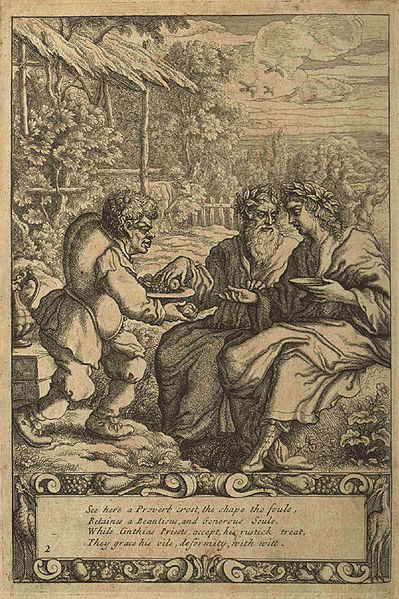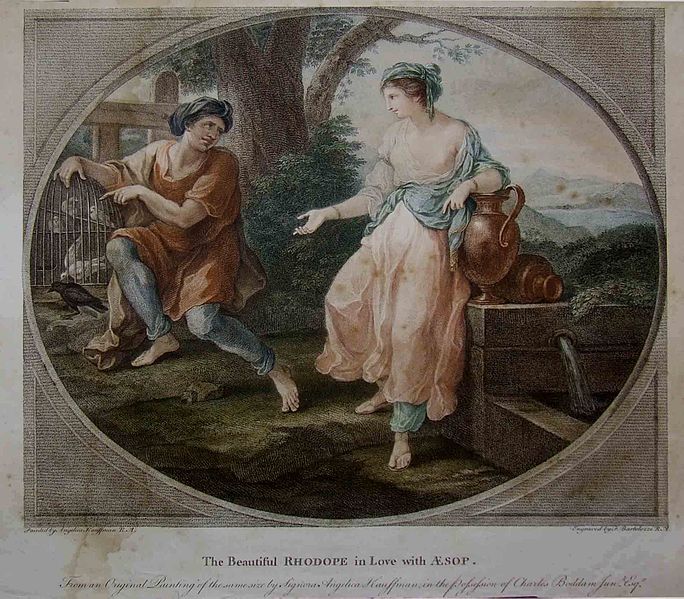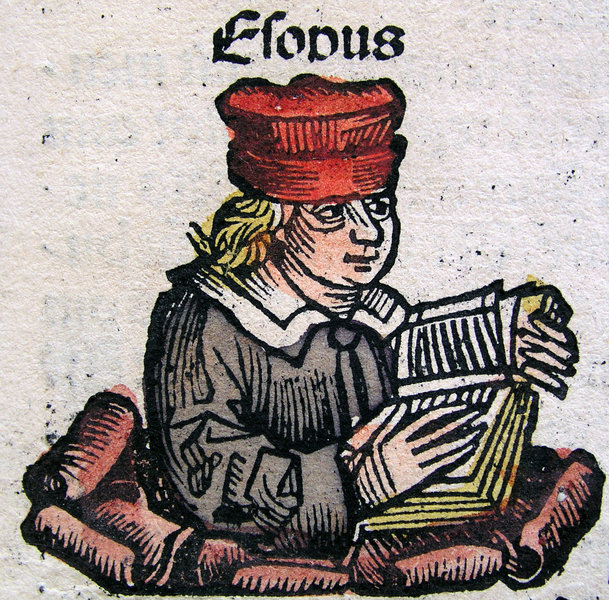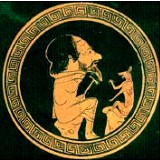<Back to Index>
- Fabulist Aesop (Αίσωπος), 620 B.C.
PAGE SPONSOR
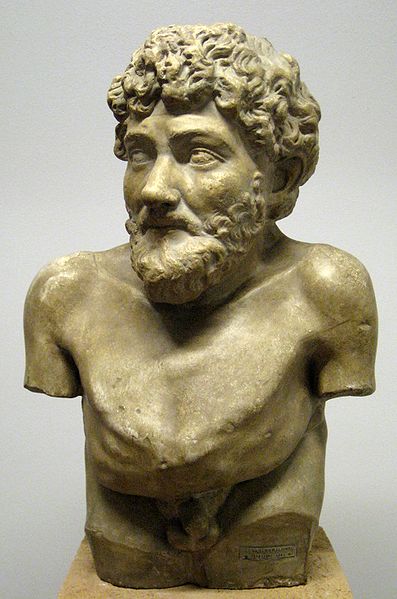
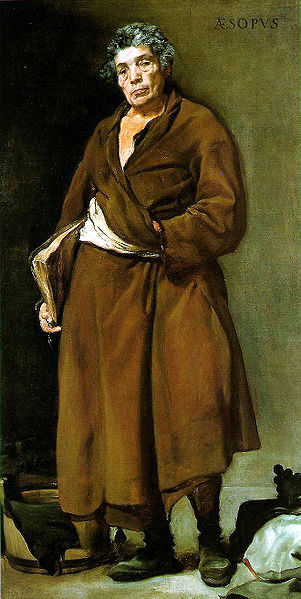
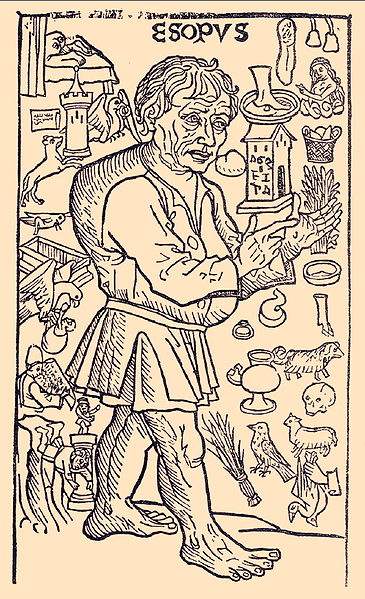
Aesop (Greek: Αἴσωπος, Aisōpos, c. 620 - 564 BCE) was a Greek writer credited with a number of popular fables. Older spellings of his name have included Esop(e) and Isope. Although his existence remains uncertain and no writings by him survive, numerous tales credited to him were gathered across the centuries and in many languages in a storytelling tradition that continues to this day. In many of the tales, animals speak and have human characteristics.
Scattered details of Aesop's life can be found in ancient sources, including Aristotle, Herodotus, and Plutarch. An ancient literary work called The Aesop Romance tells an episodic, probably highly fictional version of his life, including the traditional description of him as a strikingly ugly slave (δοῦλος) who by his cleverness acquires freedom and becomes an adviser to kings and city - states. A later tradition (dating from the Middle Ages) depicts Aesop as a black Ethiopian. Depictions of Aesop in popular culture over the last 2500 years have included several works of art and his appearance as a character in numerous books, films, plays, and television programs.
"The
name of Aesop is as widely known as any that has come down from
Graeco - Roman antiquity [yet] it is far from certain whether a historical
Aesop ever existed", writes one scholar; "in the latter part of the
fifth century [BCE] something like a coherent Aesop legend appears, and Samos seems to be its home."
The earliest Greek sources, including Aristotle, indicate that Aesop was born around 620 BCE in Thrace at a site on the Black Sea coast which would later become the city Mesembria; a number of later writers from the Roman imperial period (including Phaedrus, who adapted the fables into Latin), say that he was born in Phrygia. The 3rd century poet Callimachus called him "Aesop of Sardis," and the later writer Maximus of Tyre called him "the sage of Lydia."
From Aristotle and Herodotus we learn that Aesop was a slave in Samos and that his masters were first a man named Xanthus and then a man named Iadmon; that he must eventually have been freed, because he argued as an advocate for a wealthy Samian; and that he met his end in the city of Delphi. Plutarch tells us that Aesop had come to Delphi on a diplomatic mission from King Croesus of Lydia, that he insulted the Delphians, was sentenced to death on a trumped up charge of temple theft, and was thrown from a cliff (after which the Delphians suffered pestilence and famine); before this fatal episode, Aesop met with Periander of Corinth, where Plutarch has him dining with the Seven Sages of Greece, sitting beside his friend Solon, whom he had met in Sardis. (Leslie Kurke suggests that Aesop himself "was a popular contender for inclusion" in the list of Seven Sages).
Problems
of chronological reconciliation dating the death of Aesop and the reign
of Croesus led the Aesop scholar (and compiler of the Perry Index) Ben Edwin Perry in 1965 to conclude that "everything in the ancient
testimony about Aesop that pertains to his associations with either
Croesus or with any of the so-called Seven Wise Men of Greece must be
reckoned as literary fiction," and Perry likewise dismissed Aesop's
death in Delphi as legendary; but
subsequent research has established that a possible diplomatic mission
for Croesus and a visit to Periander "are consistent with the year of
Aesop's death." Still problematic is the story by Phaedrus which has Aesop in Athens, telling the fable of the frogs who asked for a king, during the reign of Peisistratos, which occurred decades after the presumed date of Aesop's death.
Along with the scattered references in the ancient sources regarding the life and death of Aesop, there is a highly fictional biography now commonly called The Aesop Romance (also known as the Vita or The Life of Aesop or The Book of Xanthus the Philosopher and Aesop His Slave), "an anonymous work of Greek popular literature composed around the second century of our era.... Like The Alexander Romance, The Aesop Romance became a folk book, a work that belonged to no one, and the occasional writer felt free to modify as it might suit him." Multiple, sometimes contradictory, versions of this work exist. The earliest known version "was probably composed in the 1st century CE", but the story "probably circulated in different versions for centuries before it was committed to writing"; "certain elements can be shown to originate in the 4th century BCE." Scholars long dismissed any historical or biographical validity in The Aesop Romance; widespread study of the work began only toward the end of the 20th century.
In The Aesop Romance, Aesop is a slave of Phrygian origin on the island of Samos, and extremely ugly. At first he lacks the power of speech, but after showing kindness to a priestess of Isis, is granted by the goddess not only speech but a gift for clever storytelling, which he uses alternately to assist and confound his master, Xanthus, embarrassing the philosopher in front of his students and even sleeping with his wife. After interpreting a portent for the people of Samos, Aesop is given his freedom and acts as an emissary between the Samians and King Croesus. Later he travels to the courts of (the imaginary) Lycurgus of Babylon and Nectanabo of Egypt in a section that appears to borrow heavily from the romance of Ahiqar. The story ends with Aesop's journey to Delphi, where he angers the citizens by telling insulting fables, is sentenced to death and, after cursing the people of Delphi, throws himself from a cliff.
Though
Aesop became famous across the ancient world as the preeminent teller
of fables, he did not create the genre; the earliest known story with talking animals in ancient Greek is the fable of the Hawk and the Nightingale found in the work of Hesiod, who lived some three centuries before Aesop.
Aesop may or may not have written his fables - The Aesop Romance claims that he wrote them down and deposited them in the library of Croesus; Herodotus calls Aesop a "writer of fables" and Aristophanes speaks of "reading" Aesop - but no writings by Aesop have survived. Scholars speculate that "there probably existed in the fifth century [BCE] a written book containing various fables of Aesop, set in a biographical framework." True or not, by the time of Classical Greece Aesop and the fables attributed to him seem to have been widely known. Sophocles in a poem addressed to Euripides made reference to Aesop's fable of the North Wind and the Sun. Socrates while in prison turned some of the fables into verse, of which Diogenes Laertius records a small fragment. The early Roman playwright and poet Ennius also rendered at least one of Aesop's fables in Latin verse, of which the last two lines still exist.
The body of work identified as Aesop's Fables was transmitted by a series of authors writing in both Greek and Latin. Demetrius of Phalerum made a collection in ten books, probably in prose (Αισοπείων α) for the use of orators, which has been lost. Next appeared an edition in elegiac verse, cited by the Suda, but the author's name is unknown. Phaedrus, a freedman of Augustus, rendered the fables into Latin in the 1st century CE. At about the same time Babrius turned the fables into Greek choliambics. A 3rd century author, Titianus is said to have rendered the fables into prose in a work now lost. Avianus (of uncertain date, perhaps the 4th century) translated 42 of the fables into Latin elegiacs. The 4th century grammarian Dositheus Magister also made a collection of Aesop's Fables, now lost.
Aesop's Fables continued to be revised and translated through the ensuing centuries, with the addition of material from other cultures, so that the body of fables known today bears little relation to those Aesop originally told. With a surge in scholarly interest beginning toward the end of the 20th century, some attempt has been made to determine the nature and content of the very earliest fables which may be most closely linked to the historic Aesop.
The anonymously authored Aesop Romance (usually
dated to the 1st or 2nd century CE) begins with a vivid
description of Aesop's appearance, saying he was "of loathsome
aspect... potbellied, misshapen of head, snub - nosed, swarthy, dwarfish,
bandy - legged, short - armed, squint - eyed, liver - lipped — a portentous
monstrosity," or as another translation has it, "a faulty creation of Prometheus when half - asleep." The earliest text by a known author that refers to Aesop's appearance is Himerius in
the 4th century, who says that Aesop "was laughed at and made fun of,
not because of some of his tales but on account of his looks and the
sound of his voice." The
evidence from both of these sources is dubious, since Himerius lived
some 800 years after Aesop and his image of Aesop may have come from The Aesop Romance,
which is essentially fiction; but whether based on fact or not, at some
point the idea of an ugly, even deformed Aesop took hold in popular
imagination. Scholars have begun to examine why and how this
"physiognomic tradition" developed.
A much later tradition depicts Aesop as a black African from Ethiopia. The presence of such slaves in Greek speaking areas is suggested by the fable "Washing the Ethiopian white" that is ascribed to Aesop himself. This concerns a man who buys a black slave and, assuming that he was neglected by his former master, tries very hard to wash the blackness away. But nowhere in the fable is it suggested that this constitutes a personal reference. The first known promulgator of the idea was Planudes, a Byzantine scholar of the 13th century who wrote a biography of Aesop based on The Aesop Romance and conjectured that Aesop might have been Ethiopian, given his name. An English translation of Planudes' biography from 1687 says that "his Complexion [was] black, from which dark Tincture he contracted his Name (Aesopus being the same with Aethiops)". When asked his origin by a prospective new master, Aesop replies, "I am a Negro"; numerous illustrations by Francis Barlow accompany this text and depict Aesop accordingly. But according to Gert - Jan van Dijk, "Planudes' derivation of 'Aesop' from 'Aethiopian' is... etymologically incorrect," and Frank Snowden says that Planudes' account is "worthless as to the reliability of Aesop as 'Ethiopian.'"
The tradition of Aesop's African origin was carried forward into the 19th century. The frontispiece of William Godwin's Fables Ancient and Modern (1805) has a copperplate illustration of Aesop relating his stories to little children that gives his features a distinctly negroid appearance. The collection includes the fable of "Washing the Blackamoor white", although updating it and making the Ethiopian 'a black footman'. In 1856 William Martin Leake repeated the false etymological linkage of "Aesop" with "Aethiop" when he suggested that the "head of a negro" found on several coins from ancient Delphi (with specimens dated as early as 520 BCE) might depict Aesop, presumably to commemorate (and atone for) his execution at Delphi, but Theodor Panofka supposed the head to be a portrait of Delphos, founder of Delphi, a view more widely repeated by later historians.
The
idea that Aesop was Ethiopian has been further encouraged by the
presence of camels, elephants, and apes in the fables, even though these
African elements are more likely to have come from Egypt and Libya than
from Ethiopia, and the fables featuring African animals may have
entered the body of Aesopic fables long after Aesop actually lived. Nevertheless,
in 1932 the anthropologist J.H. Driberg, repeating the Aesop / Aethiop
linkage, asserted that, while "some say he [Aesop] was a Phrygian... the
more general view... is that he was an African", and "if Aesop was not an
African, he ought to have been;" and
in 2002 Richard A. Lobban cited the number of African animals and
"artifacts" in the Aesopic fables as "circumstantial evidence" that
Aesop may have been a Nubian folkteller.
Popular perception of Aesop as black may have been further encouraged by a perceived similarity between fables of the trickster Br'er Rabbit, told by African - American slaves, and the traditional role of the slave Aesop as 'a kind of culture hero of the oppressed, and the Life [of Aesop] as a how - to handbook for the successful manipulation of superiors.' This is reinforced by the 1971 TV production Aesop's Fables in which Bill Cosby played Aesop. In this mixture of live action and animation, two black children wander into an enchanted grove, where Aesop tells them fables that differentiate between realistic and unrealistic ambition. His version there of the Tortoise and the Hare illustrates how to take advantage of an opponent's over - confidence.
On other continents Aesop has occasionally undergone a degree of acculturation. This is evident in Isango Portobello's 2010 production of the play Aesop's Fables at the Fugard Theatre in Cape Town, South Africa. Based on a script by British playwright Peter Terson (1983), it was radically adapted by the director Mark Dornford - May as a musical using native African instrumentation, dance and stage conventions. Although Aesop is portrayed as Greek, and dressed in the short Greek tunic, the all - black production contextualises the story in the recent history of South Africa. The former slave, we are told 'learns that liberty comes with responsibility as he journeys to his own freedom, joined by the animal characters of his parable like fables'. One might compare with this Brian Seward's Aesop's Fabulous Fables (2009), which first played in Singapore with a cast of mixed ethnicities. In it Chinese theatrical routines are merged with those of a standard musical.
There
had already been an example of Asian acculturation in 17th century
Japan. There Portugese missionaries had introduced a translation of the
fables (Esopo no Fabulas, 1593) that included the biography of
Aesop. This was then taken up by Japanese printers and taken through
several editions under the title Isopo Monogatari.
Even when Europeans were expelled from Japan and Christianity
proscribed, this text survived, in part because the figure of Aesop had
been assimilated into the culture and depicted in woodcuts as dressed in
Japanese costume.
Ancient sources mention two famous statues of Aesop, one by Aristodemus and another by Lysippus, and Philostratus describes a painting of Aesop surrounded by the animals of his fables, none of which have survived. Early on, the perennial representation of Aesop as an ugly slave emerged. Another recurrent motif is the love story of the slaves Aesop and Rhodopis. The tradition which makes Aesop a black African has resulted in several such depictions, ranging from 17th century engravings to television portrayal by a black comedian. Some feature combinations of these motifs, or eschew them altogether (as in the portrayal of Aesop in The Bullwinkle Show). In general, beginning in the 20th century, plays have shown Aesop as a slave, but not ugly, while Hollywood movies and television shows have depicted him as neither ugly nor a slave.
In 1843, the archaeologist Otto Jahn suggested that Aesop was the person depicted on a Greek red - figure cup, c.450 BCE, in the Vatican Museums. Paul Zanker describes the figure as a man with "emaciated body and oversized head... furrowed brow and open mouth", who "listens carefully to the teachings of the fox sitting before him. He has pulled his mantle tightly around his meagre body, as if he were shivering... he is ugly, with long hair, bald head, and unkempt, scraggly beard, and is clearly uncaring of his appearance."
Some archaeologists have suggested that a Hellenistic statue of a bearded man with a deformed torso in the Villa Albani in
Rome depicts Aesop; but as
François Lissarrague points out, "It could be the realistic
portrait of some individual unknown to us, or an expressive portrait
like others known to exist in Hellenistic art. The sole argument
advanced to identify the fabulist in this work is the facial expression:
He looks intelligent. Admittedly, this evidence is a bit meager."
Aesop also began to appear early in literary works. The 4th century BCE Athenian playwright Alexis put Aesop on the stage in his comedy "Aesop", of which a few lines survive (Athenaeus 10.432); conversing with Solon, Aesop praises the Athenian practice of adding water to wine. Leslie Kurke suggests that Aesop may have been "a staple of the comic stage" of this era.
The 3rd century BCE poet Poseidippus of Pella wrote a narrative poem entitled "Aesopia" (now lost), in which Aesop's fellow slave Rhodopis (under her original name Doricha) was frequently mentioned, according to Athenaeus 13.596. Pliny would later identify Rhodopis as Aesop's lover, a romantic motif that would be repeated in subsequent popular depictions of Aesop.
The fabulist then makes a cameo appearance in the novel A True Story by the 2nd century satirist Lucian; when the narrator arrives at the Island of the Blessed, he finds that "Aesop the Phrygian was there, too; he acts as their jester."
Beginning with the Heinrich Steinhowel edition of 1476, many translations of the fables into European languages, which also incorporated Planudes' Life of Aesop, featured illustrations depicting him as a hunchback. The 1687 edition of Aesop's Fables with His Life: in English, French and Latin included 28 engravings by Francis Barlow which show him as a dwarfish hunchback, and his facial features appear to accord with his statement in the text (p. 7), "I am a Negro".
The Spaniard Diego Velázquez painted a portrait of Aesop, dated 1639 - 40 and now in the collection of the Museo del Prado. The presentation is anachronistic and Aesop, while arguably not handsome, displays no physical deformities. It was partnered by another portrait of Menippus, a satirical philosopher equally of slave origin. A similar philosophers series was painted by fellow Spaniard Jusepe de Ribera, who is credited with two portraits of Aesop. "Aesop, poet of the fables" is in the El Escorial gallery and pictures him as an author leaning on a staff by a table which holds copies of his work, one of them a book with the name Hissopo on the cover. The other is in the Museo de Prado, dated 1640 - 50 and titled "Aesop in beggar’s rags". There he is also shown at a table, holding a sheet of paper in his left hand and writing with the other. While the former hints at his lameness and deformed back, the latter only emphasises his poverty.
In 1690, French playwright Edmé Boursault's Les fables d'Esope (later known as Esope à la ville) premiered in Paris. A sequel, Esope à la cour (Aesop at Court), was first performed in 1701; drawing on a mention in Herodotus 2.134-5 that Aesop had once been owned by the same master as Rhodopis, and the statement in Pliny 36.17 that
she was Aesop's concubine as well, the play introduced Rodope as
Aesop's mistress, a romantic motif that would be repeated in later
popular depictions of Aesop.
Sir John Vanbrugh's comedy "Aesop"" premiered at the Theatre Royal in Drury Lane, London, in 1697 and was frequently performed there for the next twenty years. A translation and adaptation of Boursault's Les fables d'Esope, Vanbrugh's play depicted a physically ugly Aesop acting as adviser to Learchus, governor of Cyzicus under King Croesus, and using his fables to solve romantic problems and quiet political unrest.
In 1780, the anonymously authored novelette The History and Amours of Rhodope was published in London. The story casts the two slaves Rhodope and Aesop as unlikely lovers, one ugly and the other beautiful; ultimately Rhodope is parted from Aesop and marries the Pharaoh of Egypt. Some editions of the volume were illustrated with an engraving by Francesco Bartolozzi of a work by the painter Angelica Kauffmann. Titled "The beautiful Rhodope in love with Aesop", it pictures Rhodope leaning on an urn; she holds out her hand to Aesop, who is seated under a tree and turns his head to look at her. His right arm rests on a cage of doves, towards which he gestures. There is some ambiguity here, for while the cage suggests the captive state of both of them, a raven perched outside the cage may allude to his supposed colour. In fact, the whole picture is planned to suggest how different the couple are. Rhodope and Aesop lean on opposite elbows, gesture with opposite hands, and while Rhodope's hand is held palm upwards, Aesop's is held palm downwards. She stands while he sits; he is dressed in dark clothes, she in white.
In 1844, Walter Savage Landor, famed for his series of Imaginary Conversations, published two fictional dialogues between Aesop and Rhodope.
Abandoning the perennial image of Aesop as an ugly slave, the movie Night in Paradise (1946) cast Turhan Bey in the role, depicting Aesop as an advisor to King Croesus who falls in love with the king's intended bride, a Persian princess played by Merle Oberon. There was also the 1953 teleplay "Aesop and Rhodope" by Helene Hanff, broadcast on Hallmark Hall of Fame with Lamont Johnson playing Aesop.
"A raposa e as uvas" ("The Fox and the Grapes"), a play in three acts about the life of Aesop by Brazilian dramatist Guilherme Figueiredo, was published in 1953 and has been performed in many countries, including a videotaped production in China in 2000 under the title Hu li yu pu tao or 狐狸与葡萄.
Beginning in 1959, animated shorts under the title "Aesop and Son" appeared as a recurring segment in the TV series Rocky and His Friends and its successor, The Bullwinkle Show. The image of Aesop as ugly slave was abandoned; Aesop (voiced by Charles Ruggles), a Greek citizen, would recount a fable for the edification of his son, Aesop Jr., who would then deliver the moral in the form of an atrocious pun. Aesop's 1998 appearance in the episode "Hercules and the Kids" in the animated TV series Hercules (voiced by Robert Keeshan) amounted to little more than a cameo.
Occasions on which Aesop is portrayed as black include Richard Durham's "Destination Freedom" radio show broadcast (1949), where the drama "The Death of Aesop," portrays him as an Ethiopian. In 1971, Bill Cosby played Aesop in the TV production Aesop's Fables.
The musical Aesop's Fables by British playwright Peter Terson was first produced in 1983. In
2010, the play was staged at the Fugard Theatre in Cape Town, South
Africa with Mhlekahi Mosiea in the role of Aesop.
